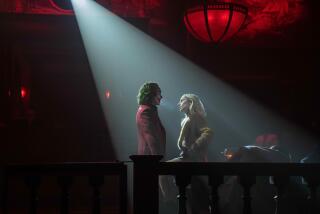In the excess, you can hear an SOS
Couldn’t they have just let “Mamma Mia!” be “Mamma Mia!”?
Even if the dictates of a profit-loving culture practically mandated the making of a film version of the uber-popular stage musical that has been seen by 30 million people in 170 cities worldwide, did they have to turn it into “Mamma Mia! The Movie” with all the excessiveness that that title implies?
Was it necessary for stage director Phyllida Lloyd and playwright Catherine Johnson, both new to feature film, to make the kind of rookie mistakes in transferring their creation to the screen that might limit this film’s audience (not that anyone will notice) to the sizable group of the already converted?
Frankly, I wouldn’t have thought I’d be part of that group, but I am. I saw the stage musical that cleverly knit together a heap of songs by the Swedish pop group ABBA when it opened in Los Angeles prior to its New York run and, to my surprise, I became one of those who found a show with pop anthems like “Take a Chance on Me” and “Dancing Queen” difficult to resist.
The refreshing thing about the “Mamma Mia!” show was that it dared to be simple. Just those 18 songs, adroitly presented, with just enough plot, dancing and stage business to get you cleanly from one to the other. That’s all anyone cared about and, frankly, that’s all anyone should have cared about.
But in the transition to film the “Mamma Mia!” brain trust just couldn’t resist overloading the story with unneeded improvements. Lured by the siren song of a Hollywood budget, they allowed themselves to be fooled into thinking that bigger -- more singers! more dancers! more bad jokes! -- would automatically be better. It’s not necessarily so.
So while those ABBA songs are still there, they now have to fight for our attention against overstuffed production numbers that wear us out rather than entertain. Unamusing new dialogue must be put up with, and though an overmatched Meryl Streep acquits herself well in the starring role, we have to endure the strained antics of the likes of Julie Walters, a serial over-actor who has been encouraged in her worst tendencies.
Though the filmmakers may have been imagining they were re-creating the old days of MGM musicals, it’s the Village People’s misguided “Can’t Stop the Music” that comes to mind instead.
As much as it can be seen under all this excess, the “Mamma Mia!” story line, set on the kind of Greek island that exists only in tourist brochures, remains pretty much intact.
Things begin with Sophie (Amanda Seyfried), a young woman who is about to be married, posting a trio of letters in a mailbox with a full-color brightness that has not been seen since Dorothy walked down the Yellow Brick Road.
Raised by her innkeeper mom Donna (Streep), Sophie has never known who her father is. Some discreet snooping has given her a list of three likely suspects. There’s architect Sam (Pierce Brosnan), banker Harry (Colin Firth) and writer Bill (Stellan Skarsgard). Unable to tell who is likeliest, Sophie invites them all to her wedding.
Naturally, everyone shows up, as do Donna’s old pals Rosie (Walters) and Tanya (Christine Baranski), her backup singers in a group called Donna and the Dynamos. That’s enough of a crowd to lead to all kinds of nominally comic crossed signals and mixed messages.
A sage once advised being wary of movies in which the people on screen are having more fun than the people in the audience. Mamma mia, was that good advice.
--
“Mamma Mia!” MPAA rating: PG-13 for some sex-related comments. Running time: 1 hour, 48 minutes. In general release.
More to Read
Only good movies
Get the Indie Focus newsletter, Mark Olsen's weekly guide to the world of cinema.
You may occasionally receive promotional content from the Los Angeles Times.










